Carefully I clamped the round pressed sushi with my chopsticks, trying to figure out the correct way to eat these larger-than-normal rolls of rice and fish. The real struggle though was not about how to eat it properly, but rather how to do everything in utter silence. The other diners who were sitting a table apart from us seemed to pull it off effortlessly. All of their attention was focused on what they were eating. No sounds: just a few short, quiet conversations between courses. I tried not to make even the slightest noise with my chopsticks, while thinking ‘how am I going to take photos of these unique delicacies as quietly as possible?’.
James and I were at Izuu, a nondescript small restaurant in downtown Kyoto better known to locals instead of tourists, as seen in the absence of Latin script outside its wooden facade. People come to Kyoto to see what is ancient, chiefly its temples, shrines and palaces, and many of those places are still actively in use to this day. However, finding a local establishment that is ancient is a lot more difficult as modern eateries and shops have become the norm. But when you find one such restaurant, it’s almost certain that you’ll be treated to among the best and most elaborate dishes you can find in the entire country. First opened more than two centuries ago in 1781, Izuu is one of those rare places, and we were lucky to be able to find it and experience its simple, albeit a little intimidating, ambiance.
Throughout the establishment’s many years in business, there is one dish that hardly changes: a Kyoto-style sushi called saba-sugata-zushi, cured mackerel pressed on to sushi rice and wrapped in thick kombu (kelp). The city’s affinity with cured mackerel is by no means a coincidence. Because Kyoto is situated inland and far from the coast by local standards, the fish was transported centuries ago on foot from the Sea of Japan on Saba Kaido, the old mackerel road. Curing was the only option to make the fish last long over the long distance traveled.
Being a heritage dish which not everyone can prepare means the price is rather steep for a portion (six pieces) of the sushi. But as soon as I took the first bite I understood what made it special: balance is key as each component of the dish didn’t overpower one another. We also had tai-zushi, made from cured sea bream with a lighter kombu to match the more subtle flavor of the fish. Despite my initial nervousness for eating at such an unbelievably quiet restaurant, it all made sense after we finished devouring the delectable dishes. Such delicate flavors can only be appreciated when you allow your palate to be fixated on the dishes without the disruptions from other senses.
As much of an unforgettable experience our lunch at Izuu was, we also looked for a more contemporary take on Japanese cuisine, which we happily found at Sagan, just a few minutes walk from where we stayed. It was rather a coincidence that we discovered this restaurant as we were wandering aimlessly to find a place for dinner. Occupying a machiya (traditional Kyoto townhouse) which has been fitted with modern touches, I was pleasantly surprised by how cozy it was inside. In spite of its location, Sagan’s ambiance and look is suggestive of a hipster café in a more cosmopolitan city instead of a tranquil neighborhood in Kyoto.
After perusing the beautifully-done hand-drawn menu, we opted for their rice and fried salmon which came with miso soup, fluffy egg, stir-fried beansprouts, and a lot more vegetables, from lotus root to turnip, each yielding a distinctively Japanese sweet taste. The steamed pumpkin was so soft and sweet, the julienned carrots cooked perfectly, and the salmon so flavorful. This very satisfying meal was enough reason for us to return for lunch.
For a more vibrant and lively atmosphere with a lot of options of authentic Japanese food there’s no place in Kyoto like the city’s own kitchen: Nishiki Market. Spanning five blocks on an east-west axis, the covered traditional market is a haven for foodies. From fresh oysters to bright salmon roe, grilled scallop to Japanese pickles, it’s a place one should visit on an empty stomach.
Walking past a few shops selling Japanese vegetables, suddenly these bright red items caught my attention. Upon closer inspection I figured out what they were: baby octopuses smothered in sauce glistening under the shop’s light. I had tried baby octopus in Jakarta before but the ones I saw at Nishiki Market looked rather different: their heads appeared to be filled with something that made them appear very round. Tako tamago, apparently, is a baby octopus marinated with a sweet and savory sauce and stuffed with a boiled quail egg. Not expecting it to be so tasty and addictive, I ended up having two (or three) more octopuses during our time at the market. Had we spent one more hour there I’m sure I would have grabbed my fourth (or fifth) baby octopus!
We continued exploring the colorful market with our eyes wandering from one tantalizing delicacy to another, and decided to drop by a shop that served unagi no kimo – eel liver. As I bit into the brown fried liver whose texture was slightly reminiscent of chicken heart, rich flavors exploded inside my mouth. Who would’ve thought these fried organs could be so flavorful? With two exceptionally delicious snacks in a row, we became even more curious about what other unique dishes this market had to offer.
Due to the lack of space, at most shops patrons have to eat while standing, although a few do provide one or two small tables for people to dine a little more comfortably, like what we did while having grilled squid served with soy sauce. The squid was of course very good and fresh, but the best grilled seafood we had at the market was definitely these skewered scallops we had at another shop which were so plump, juicy, sweet and a little smoky. Unsurprisingly James, a big fan of scallop, bought another skewer.
For sure not everything at the market was savory. We stumbled upon a mochi shop where we had matcha warabi mochi (green tea mochi), and being a person who loves both matcha and mochi I found the ones we had a real treat to cleanse our palates in between those savory bites. Another interesting dessert we had was tonyu (soy milk) donut, made fresh as we ordered. For serving, the fried donuts were lightly drizzled with what seemed to be brown sugar liquid and dusted in Japanese soybean flour. It was sweet, but not too much, and at the same time very light – perfect to wrap up our exploration of Nishiki Market. From centuries-old traditional food to modern cuisine, baby octopus to soy milk donuts, Kyoto really spoiled our palates. It was a day well-spent and a few kilograms well-gained.

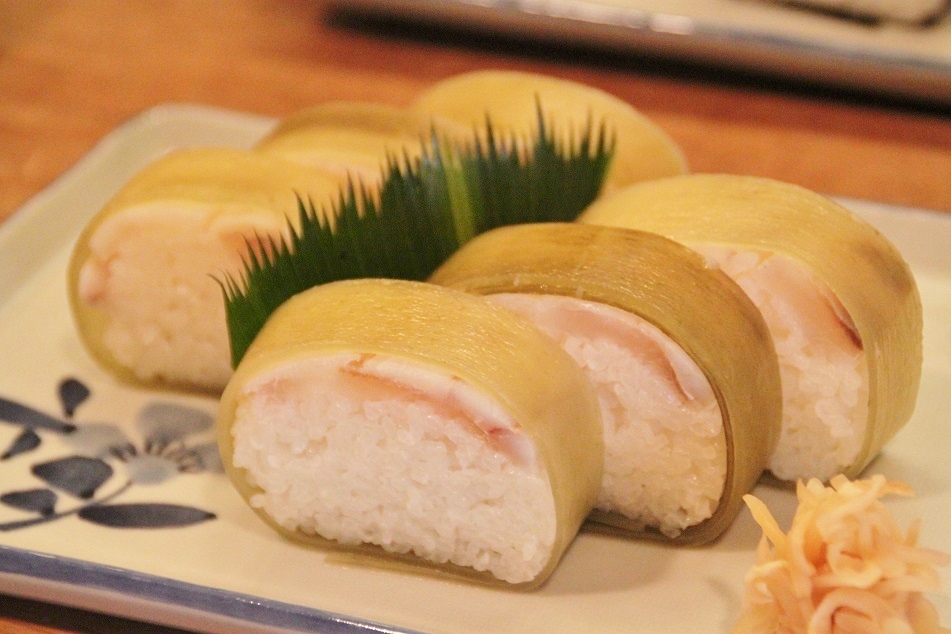
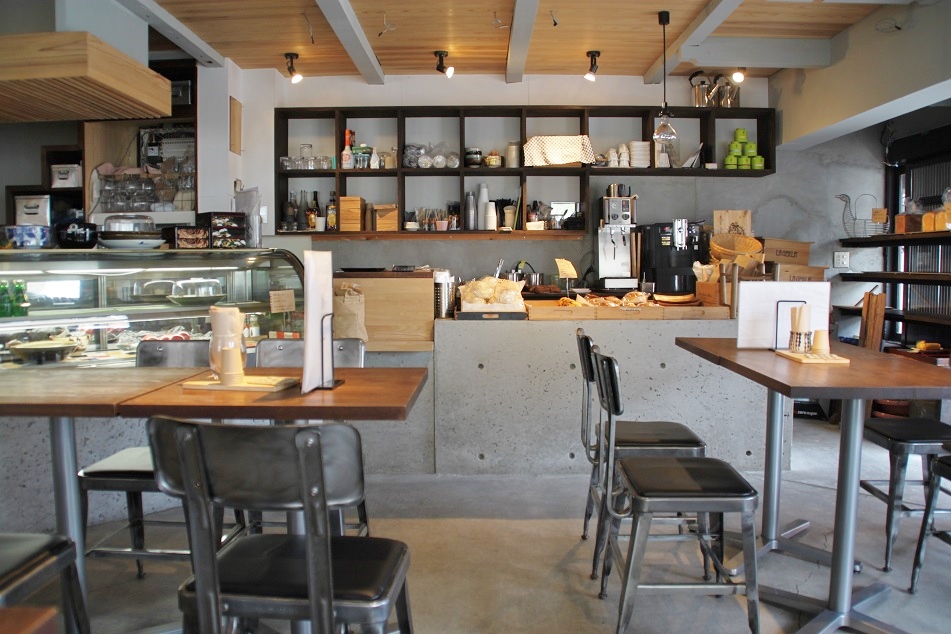
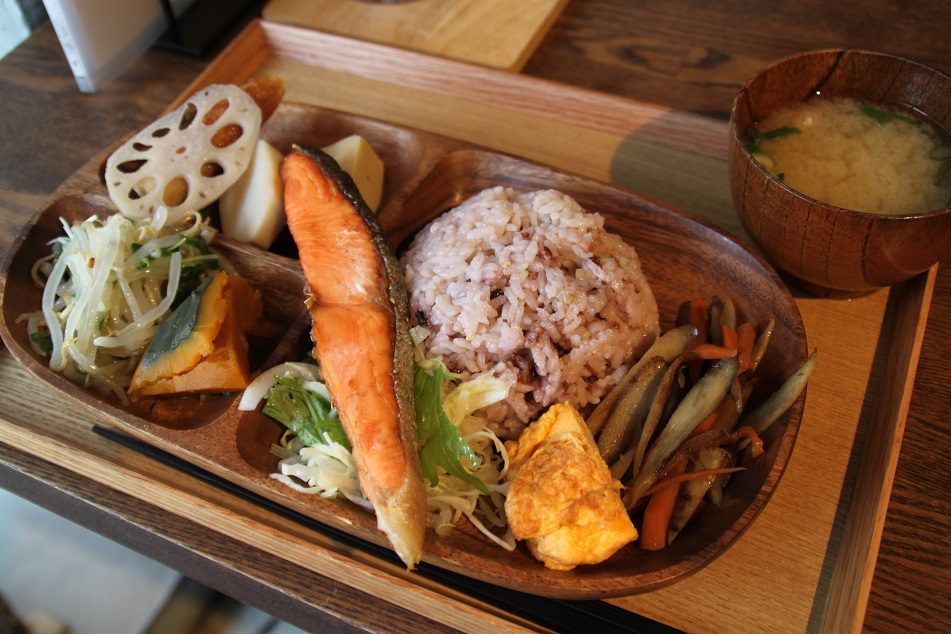
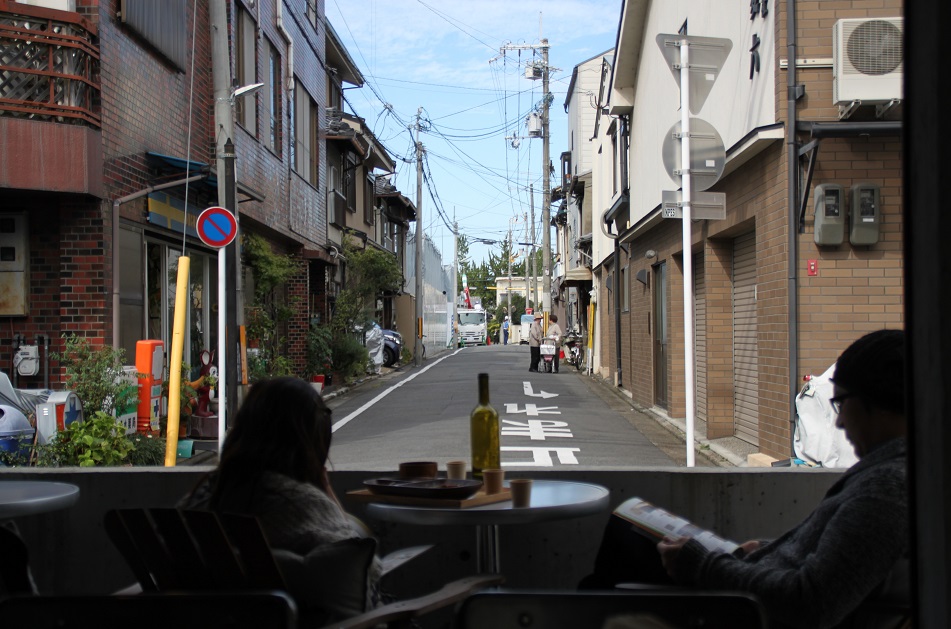
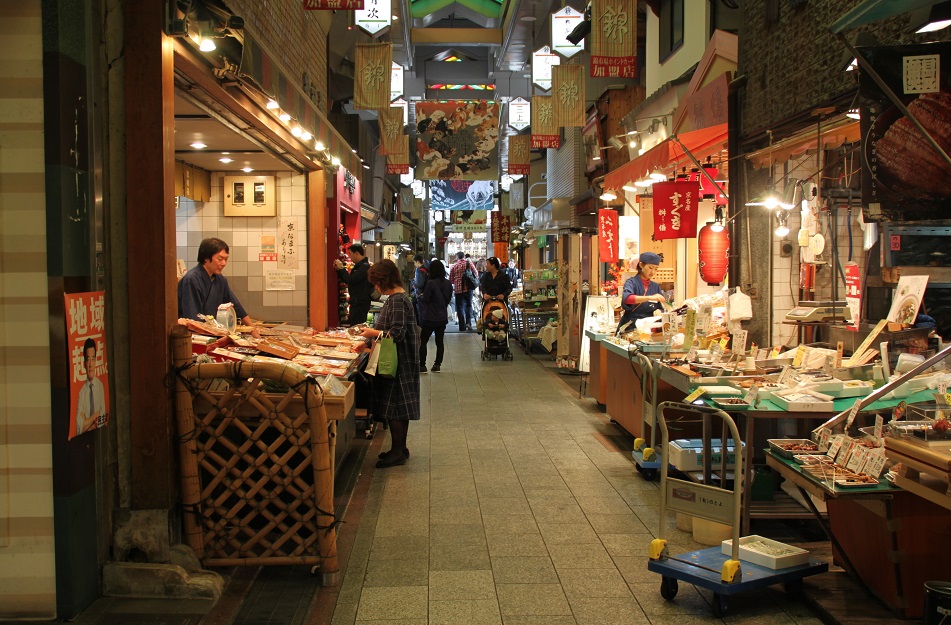
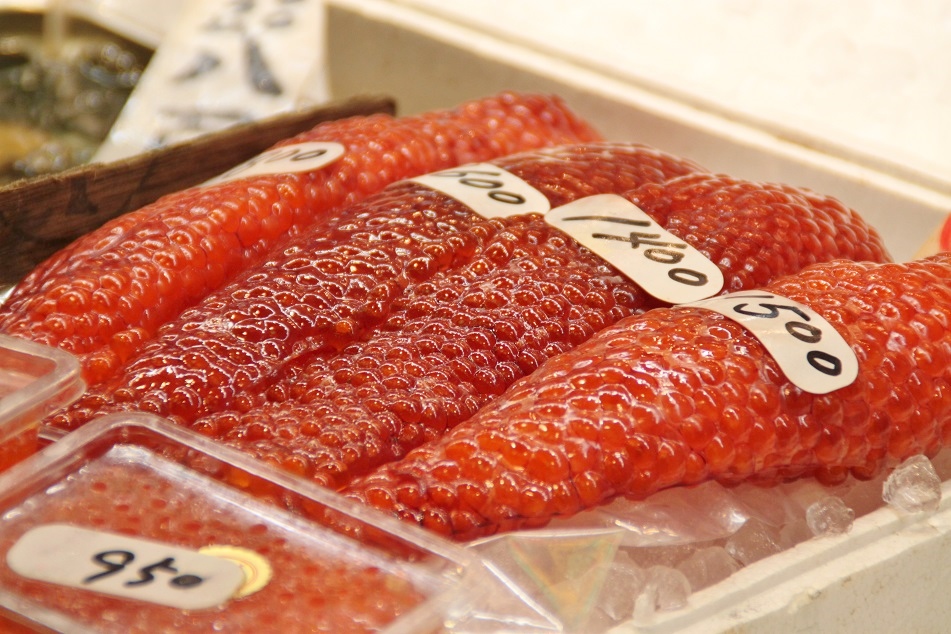
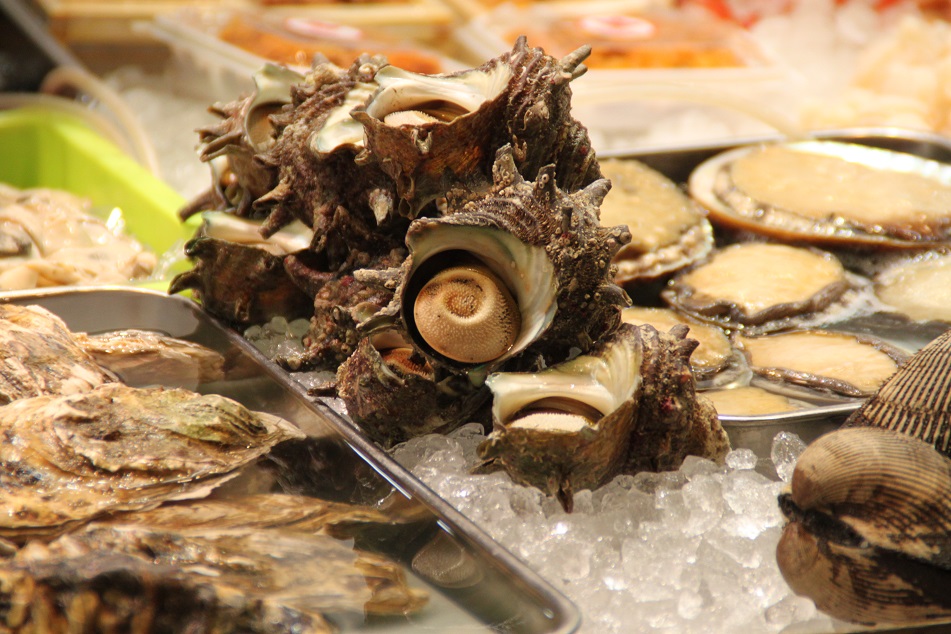

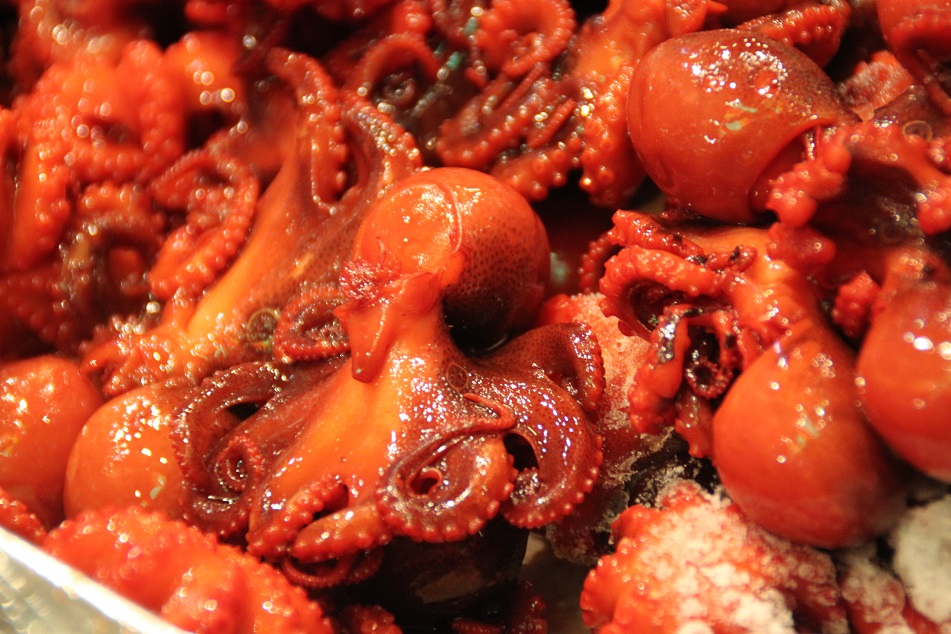
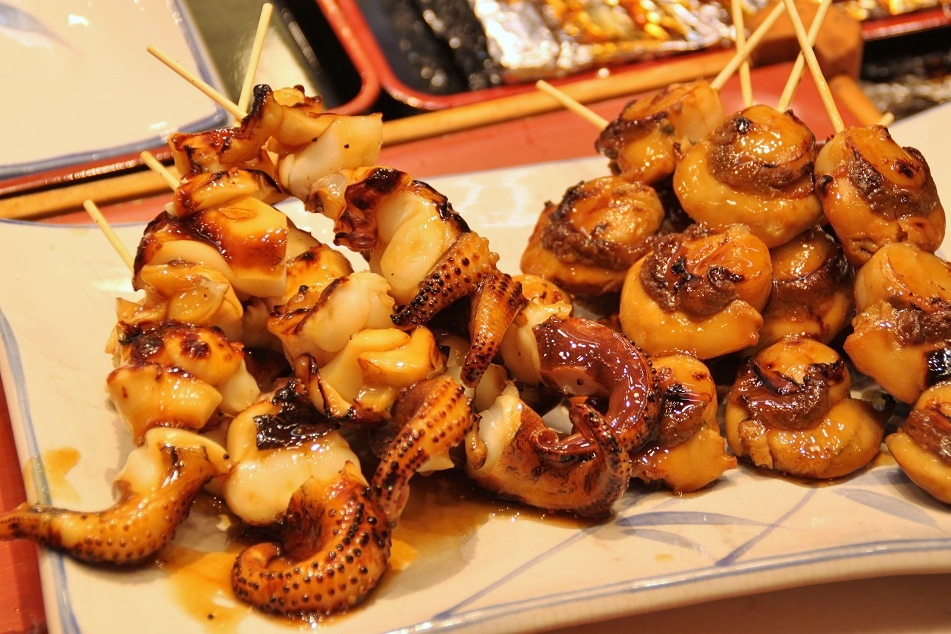
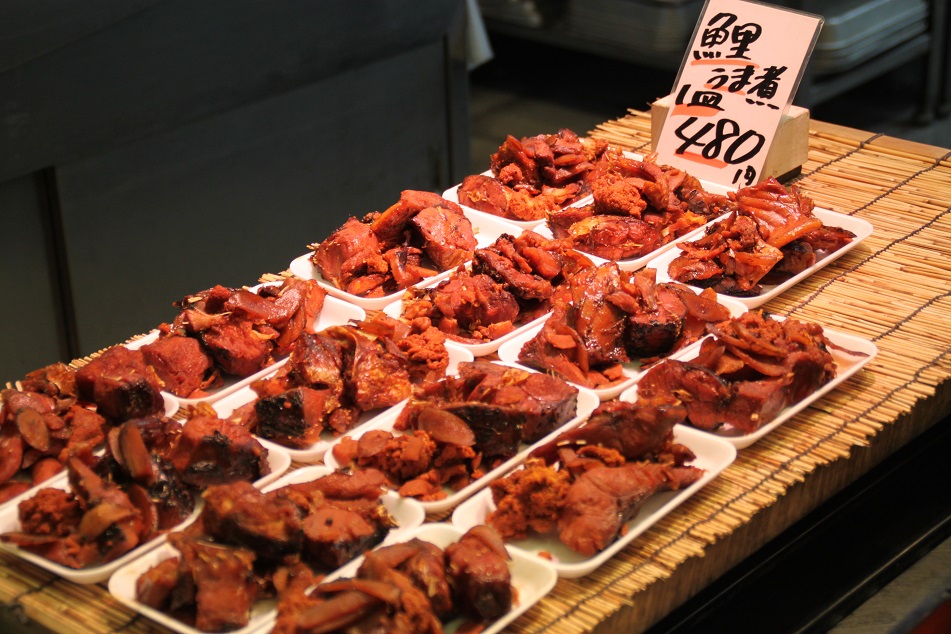

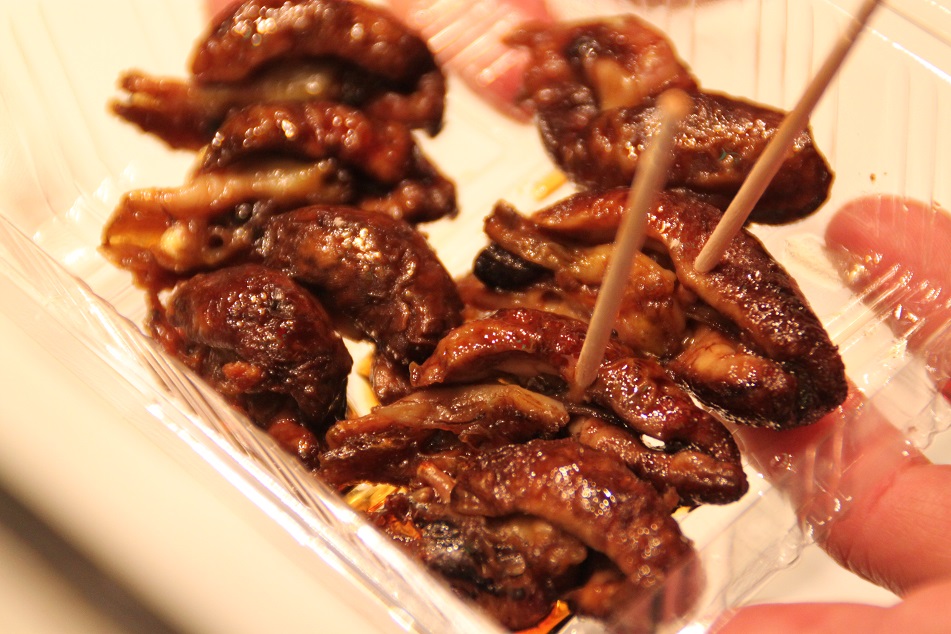

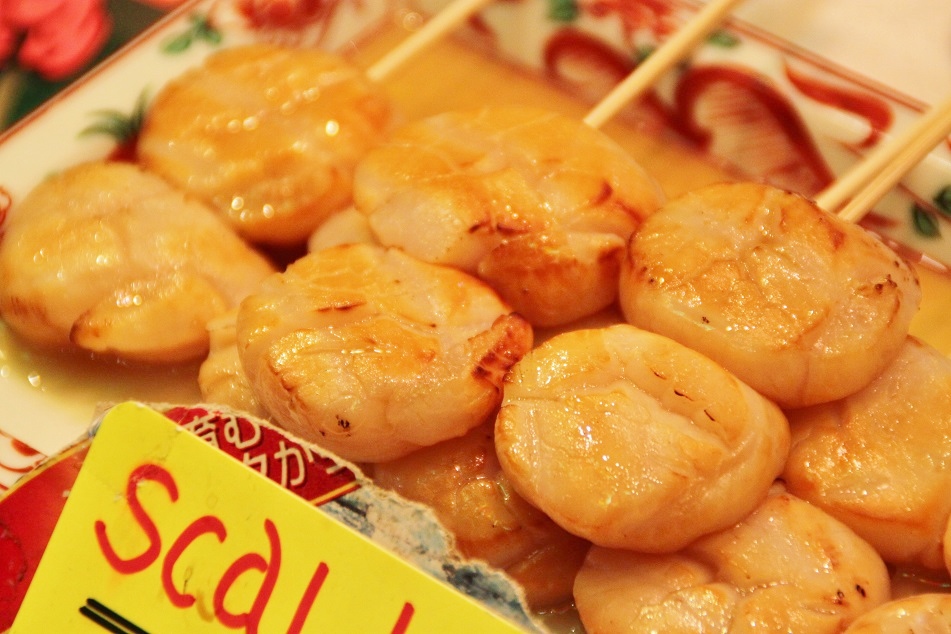
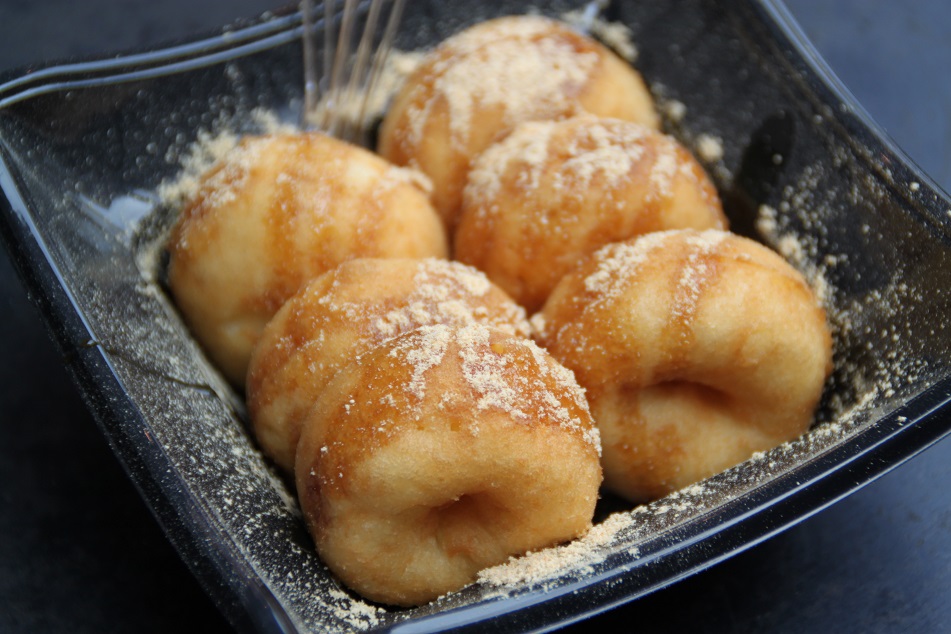
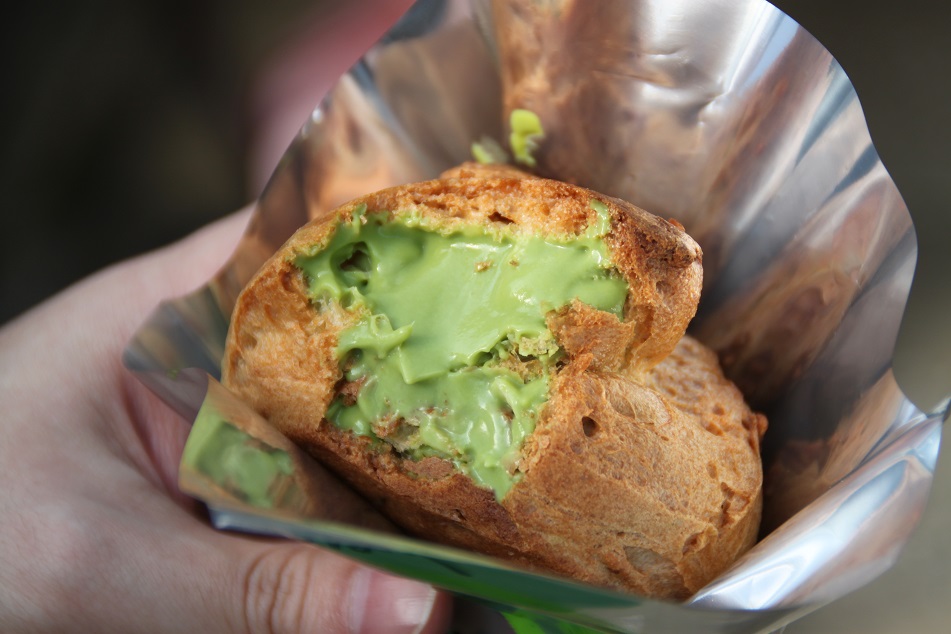
I was there just in April. They were selling grilled sparrows at Nishiki market. 😏
LikeLike
Grilled sparrow? I thought the bird was too small for that. Did you try it, though?
LikeLiked by 1 person
No. We already had lunch and were too full to try the snacks along the market.
LikeLike
Wow, the seafood dishes are looking great! Do they taste good too?
LikeLike
They certainly did! Based on my experience, Japan is a place where getting bad food is almost impossible.
LikeLiked by 1 person
To be honest with you I was never a big fan of Japanase cuisine. However I have been more and more curious of Japan and its food lately. People have been telling me to visit Japan and try the “real’ Japanese food which is different to what we get here. And here I am reading your post, trying to imagine those soy doughnuts and mochi (I’m a sweet tooth so naturally that caught my attention first haha) but also really drawn to the baby octopus and sushi too! My mouth is watering at the thought 😀
LikeLike
I think you should give real Japanese food a try, and if you end up still not liking it at least you get to visit this beautiful country. 🙂 About the mochi, what I had in Japan (especially in Osaka) is definitely the best mochi I’ve ever tasted so far. The ones I had at Nishiki Market were equally satisfying.
LikeLiked by 1 person
Eating well indeed ~ it seems you found all the great delicacies in Kyoto. I like the way to go out to try to find the small restaurant in Kyoto (or anywhere you travel), a place that attracts the locals so you get a better taste of the real culture. Love the photos too, as always, although I must say the last shot of the Green Tea Choux Pastry looked a bit bizarre 😀 Cheers to continued wonderful travels.
LikeLike
Thanks to James we managed to find Izuu — not the easiest place to look for, to be honest. However, only long after that trip to Japan did I realize that we ate the sushi in the wrong way: instead of eating the kombu, we should’ve peeled it and put it aside.
Thanks Randall! About that choux pastry, I have to say anything with green tea would look good to me, no matter how strange it might appear to some. 🙂
LikeLike
Holy moly! What an array of exotic treats — hats off to you for being so adventurous in sampling so many of them. I don’t think I’ve ever seen a post on WordPress that went so deep into the food culture in Kyoto, so you’ve really opened a whole new world to me. Beautiful photos, too!
LikeLike
Kyoto surely has some of the most beautiful and historically-important heritage buildings in Japan. But its culinary scene is something worth exploring as well. That lunch at Izuu is certainly one of the most memorable dining experiences for me, and I can still remember how cozy Sagan felt, not to mention all those delicious snacks my friend and I tried at Nishiki Market. I would go back in a heartbeat just for the food! Thanks Heide.
LikeLiked by 1 person
You make me nostalgic. It has been too long since my last visit.
LikeLike
Glad this post jogged your memory of your past trip to Kyoto. Isn’t it a very fascinating city?
LikeLike
Very. So many different things to do
LikeLike
Ah, this mouth-watering post sure brings back some fond memories! Good thing I read it just after dinner. 🙂 Bama, I have to say that Izuu was the most nerve-wracking sushi experience I’ve ever had… the sheer silence inside the restaurant was quite uncomfortable and felt like the complete opposite of what I envision the best meals to be – a laid-back social experience. The sushi was of course delicious and sublime, but I much preferred the ambiance at Nishiki Market!
LikeLike
A more laid-back ambiance would have been nice, but had we not experienced Izuu the way it’s supposed be, we wouldn’t have had this story to reflect on and laugh at. I read that there is another restaurant in Kyoto which serves dishes similar to those at Izuu. I don’t remember why we didn’t stay longer at Nishiki Market; if we did I would certainly have devoured more tako tamago!
LikeLiked by 1 person
Baby octopus with quail egg looks like a lollipop. Nishiki market looks exotic. I think I would perfectly fit in Izuu. Thanks for sharing your experience, this post and pictures makes me want to visit this beautiful country and feast there.
LikeLike
Actually it really does, although with many arms. 🙂 Hope you’ll get the chance to visit Japan and try those delectable dishes!
LikeLiked by 1 person
OMG, I have many friends who are students there. I really want to meet them and try all of food above. Hahaha
LikeLike
You know how much easier it is now for Indonesians to visit Japan. So, what are you waiting for? 🙂
LikeLiked by 1 person
The photos are amazing! You sound like an adventurous eater – I am not sure if I’d even try half of the dishes from the market, although they do sound amazing from the way you’ve described them 😀 Just strolling around the market with such unique dishes would make me very happy too.
Baby octopuses look good, I think I’d try those but eel liver on the other hand makes me go eeeekkk..No surprise Japan seems to have such a huge selection in seafood. I was introduced to it later in life after I moved away from Nepal, but it has been pretty limited to some of the things that I actually like (e.g salmon and shrimps). I tried mussels and squid in the Philippines but wasn’t that impressed by either of them. I think it’s the kind of food that might take some time to get used to, like sushi hehe.
LikeLike
I can say that I eat most things, even those many find unappealing or gross. You’ll never know how something tastes until you try it, right? 😀
Oh you shouldn’t give that eel liver a miss! Imagine foie gras with a slightly more chewy texture and intense flavor. The Japanese really know how to make great produce; from the juiciest and sweetest of fruits to the most succulent meat and the freshest seafood, most dishes are produce-driven which means even the smallest amount of seasoning is enough to make a dish shine. You must try the mussels and squid in Japan then.
LikeLike
Yum! Can’t wait to sample these treats. Only six weeks to go.
LikeLike
Yay! Six weeks is not that long. Remember to visit Nishiki Market on an empty stomach! 🙂
LikeLiked by 1 person
I’ve made a note. Thanks
LikeLiked by 1 person
I feel like I would also like the Tako Tamago. That sweet red glaze looks divine. Also, I find it fascinating how different cultures enjoy their food in silence. You presented such a great first person experience about your time at the restaurant with your friend eating the massive sushi – it reminded me of the times during which I was in a similar situation during some of my travels. I will say that this process of enjoyment is definitely not shared in many parts of the USA. It’s in and out as fast as you can and the faster the better. It’s rather unfortunate and I see how it plays a role in our size/health as a nation. Whenever I travel to a new place, I make it a point to explore a bazaar or market. It’s such a bewildering experience to see what different cultures find tasty. I have yet to do that with a foreign friend in the USA as a matter of fact, my foreign husband does not count since he’s sooo many years accustomed, but I do remember him commenting on how shiny and plastic the apples look in the produce section.
LikeLike
Different cultures do have different preference not only in what to eat, but also how to eat. While at Izuu silence is valued, I remember someone told me that in France it is actually considered rude to eat without making conversation with other people around the table. Then of course some people eat with knife and fork, some with spoon and fork, some with chopsticks, and some with their bare hands. Traveling and tasting the local food the traditional way really help us broaden our perspective and judge less, because what is good and decent from our cultural point of view may not necessarily be perceived in the same way elsewhere.
Thanks for reading and sharing your interesting thoughts, Jess!
LikeLiked by 1 person
I absolutely love markets especially when the offerings are so different from what I see at home. Thanks for close-up shots of all these things from the sea. They’re kinda slimy looking to me, but to those who love them, they are probably delicacies.
LikeLike
Going to traditional markets is probably the first step to understanding a culture that is different from ours better. Slimy the seafood may seem, but since they’re very fresh all you can taste is this natural sweetness.
LikeLiked by 1 person
I didn’t know that Kyoto has their own version of sushi. They look so tempting! It seems that I have to return to Kyoto for this special sushi 🙂
LikeLike
I didn’t know either until I came to Kyoto. Don’t expect fresh flavor like what you’d typically taste when you have nigiri sushi or sashimi. The cured fish really gives the dish a very unique flavor. Next time you’re in Kyoto make sure not to miss this type of sushi!
LikeLiked by 1 person
Fore sure! Won’t miss it the second time 🙂
LikeLiked by 1 person
You are so much more adventuresome than I, at least when it comes to food! I was so happy that there were no photos of the octopi or the eel livers as I read about them, but aha – there they were at the end! I actually like grilled octopus, but those red guys with their stuffed heads …? … I don’t think I could do it. The first two places sounded amazing, the quiet traditional and the trendy modern – your food at both looked amazing, and I’d enjoy getting to experience both ambiances.
LikeLike
I know it sounds sinister, and the Japanese do have some of the craziest ideas for many things, but at least those octopuses are not eaten alive. In Korea they do just that, and from what I read it can be dangerous. I saw one restaurant in Seoul which served live octopus, but James and I decided to go to another restaurant right across the small street and had the most amazing bulgogi we’ve ever tried.
LikeLike
Love the look of all the different foods! I would love it if you could check out my blogs 🙂
LikeLike
Thanks for dropping by! To me those dishes not only look good, but also taste good. The Japanese really know how to make everything delicious.
LikeLiked by 1 person
Some seriously interesting-looking octopus over there, Bama! I once stayed in Kyoto in a house where one of the walls was made in that kind of pre-fab concrete like the counter of Sagan (the one with the drilled holes at regular intervals); it looked a bit like that restaurant, for décor and style, and I really found myself wishing to have a house like that!
LikeLike
I wonder whether what is now Sagan was in fact the place where you stayed, or maybe there are more than one houses which are modeled after the same type of interior design. I remember the moment I stepped into Sagan, I felt comfortable immediately. It would be nice to have a house like that, indeed! As for the octopus, unfortunately here in Jakarta I can only find chuka idako (seasoned baby octopus) which at a glance looks similar with tako tamago but with a conspicuously absent quail egg.
LikeLiked by 1 person
Hello Bama, great pictures, your pictures make me hungry 🙂 I bet that salmon lunch and the freshly-made Tonyu Donuts were delicious, thank you for sharing!
LikeLike
Thanks Liz! I hope you didn’t read this on an empty stomach. 🙂 Ohh that salmon lunch not only tasted so good, but it was also very healthy. As for the donuts, what I liked the most about them was the fact that they were not too filling with just about the right amount of sugar.
LikeLiked by 1 person
It all sounds and looks so delicious from your accounts. Quiet contemplative eating is my sort of world.
LikeLike
Oh I can imagine how much you would love the ambiance at Izuu! Food really is the only thing that matters there. When you do come to this restaurant one day, I’d love to read your take on this kind of dining experience.
LikeLiked by 1 person
Your and James’ astounding adventures are giving you quite an education in foods of the world! (I would have had the scallops, one of my favorites!)
LikeLike
If only I started traveling with James much earlier, because back in the days before I met him I wasn’t as adventurous in trying new dishes as I am now. You would love those grilled scallops, Marilyn!
LikeLike
Sounds a delightful place for seafood lovers! Unfortunately I don’t eat seafood 😦 but would love to try their Tonyu donuts (I like the idea that it was made from soybean flour) and green tea pastry or ice cream ❤ Yum!
LikeLike
If you love a dessert that is not too sweet, I think you’d love tonyu donut. I believe that shop also serves another type of donut, but I can’t remember what that exactly is. There’s certainly more than just seafood at Nishiki Market, Indah. So even if you find yourself going there one day, you won’t be starving! 🙂
LikeLike
OMG! I just loooove sushi and seafood. Great pictures Bama!
LikeLike
Then for sure you would love Nishiki Market! I myself would certainly go back there if I get the chance to return to Kyoto. Thanks Victoria!
LikeLike
Bama I may need to stick to the donuts. I’m afraid I am terrible with chopsticks. I’m also leary of the wee octopi. I shall leave the grand food adventures to you. 🙂
LikeLike
The donuts and those skewered snacks then. 🙂 I guess the ‘advantage’ of growing up in Asia is I have been exposed to strange and slimy food since I was a kid. However, there are a few things eaten by the people in some parts of Indonesia which I find too bizarre to my liking, like bats and monitor lizards.
LikeLiked by 1 person
Wowza Bama I am a definite no to bats and monitor lizards. In Vietnam when I saw the rats being sold in the markets I became a strict vegetarian for the rest of the Asia adventure.
LikeLike
Speaking of what you saw in Vietnam, it reminds me of what I saw in Cambodia when I went there seven years ago. One afternoon I was walking around the promenade by the Mekong, then I spotted something unusual on a skewer, sold by a street vendor. I came closer only to realize that it was grilled snake! I didn’t try it though.
LikeLiked by 1 person
Oh my goodness no snake skewer for me. In Cambodia we were presented with large trays of tarantulas, crickets and larvae. Sadly I understand the history of this comes from the desperation of starving people in the late 1970’s. Hard to imagine.
LikeLike
I want to go to Kyoto even more now!
LikeLike
You really should. It offers not only ancient temples, but also delicious snacks and dishes.
LikeLike
I am honestly not sure if I would eat and/or like all of the food that you photographed 🙂 But for sure you captured the elegance of Japanese food. Sushi has become immensely popular in the Netherlands in the past years, but never will it match the taste that you experience in Japan…
LikeLike
I’m glad I grew up in a part of the world where nothing is too bizarre to eat. 🙂 Just give them a try, Emiel, and see what you think of them. You might end up liking some of the things you thought you wouldn’t enjoy. Sushi has become popular in Indonesia as well, especially in big cities. In Jakarta you can find sushi restaurants/stalls almost everywhere, from luxury malls to shopping centers dedicated to cheap clothing. But since I prefer nigiri sushi, I usually avoid going to places that look dubious.
LikeLike
Bama, your food posts are always such a treat to the senses. I’d be squeamish to try the eel liver, perhaps even the baby octopus but much of the other stuff looks appealing. I tried smoked eel and raw herring in Amsterdam this time and was pleasantly surprised by how good it tasted and have vowed to at least taste seemingly strange local food wherever I go. I need to remember to click photos of my food first! 😀
LikeLike
Thanks Madhu! What’s interesting about the baby octopus, apart from its taste, is its slightly crunchy texture. As for the eel liver, just think of chicken or beef liver — it’s really not as bizarre as it may sound. I’ve heard about the raw herring and been wondering if it’s more like an acquired taste. But from what you said it sounds quite delicious! You know, before I started traveling with James I wasn’t really a foodie. But now we always make sure to try dishes we can’t find at home, no matter how unusual it may sound or appear, when we travel.
LikeLike
I absolutely love tako tamago! I don’t think I will dare to try eel liver though, no matter how divine your description is. I can’t stand the taste of innards..
LikeLike
Isn’t tako tamago amazing? The Japanese do know how to come up with such bizarre ideas that actually work. Never say no to eel liver; you may end up really enjoying it! 🙂
LikeLiked by 1 person
Yes, indeed! Haha I will give it a try!
LikeLike